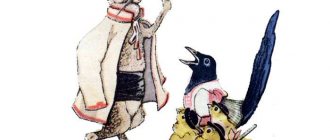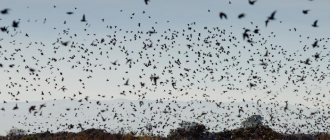The world around us for children 5-8 years old “Wintering birds”. Magpie
The magpie has many nicknames: the white-sided magpie, the chirping magpie, and even the thief magpie.
White-sided, because the feathers on the sides of the magpie are completely white. The head and wings are black. The tail is also black, but with a very beautiful greenish tint, long and straight, like an arrow.
The chirping magpie is called the chirping magpie because, flying from place to place, it chirps loudly: “Cha-cha-cha!” With a loud, alarming chirping, magpies warn forest inhabitants of danger.
It’s not for nothing that the magpie received the nickname “thief”, because she really loves everything bright and shiny. In a magpie's nest you can find pieces of metal wire, a shiny button, beads, and sometimes even a teaspoon.
The magpie is also called the “forest newspaper”, and about interesting news they say: “The magpie brought it on its tail.”
Magpie
I know every bush in the forest,
I carry the news on my tail.
Maybe it's me for this
And they call it “forest newspaper”?
Magpies love to build nests in willow thickets along the banks of forest rivers and streams, in young light and spacious pine forests, in clearings and on the edges. The magpie's nest, built from dry branches, is large and comfortable. Inside the nest is a bowl made of clay and covered with down, wool, straws and blades of grass. This structure is protected from the weather by a real roof: the magpies place branches and twigs at an angle, which form a dome.
Magpies are not lazy and build several nests at once, and then choose the best one from them. Five or eight rather large eggs soon appear in this nest, which the female incubates.
After three weeks, the eggs hatch and the little magpies squeak loudly, their bright red mouths opening wide. Parents feed their babies all day without a break.
Remember the rhyme about the magpie?
She cooked porridge and fed the children.
In fact, the white-sided magpie does not cook porridge for children. She feeds the chicks with caterpillars, midges, beetles and mosquitoes. In addition to insects, magpies peck at berries and fruits, plant seeds, and sometimes they can destroy someone else's nest or catch a small animal.
In the autumn, magpies gather in small flocks, fly around gardens and parks, and eat rowan, hawthorn and sea buckthorn berries.
Long-tailed rattles do not fly away from us to the southern regions. In winter, birds move closer to people - they fly to villages and settle in the outskirts of the city. Being around a person makes you feel more nourished and warmer.
Source
Lifestyle
In summer you can rarely see a magpie in a city park, but in winter they often look into the feeders of other birds. Magpies in nature lead a sedentary lifestyle; they never fly away from their home for long. Where there are a large number of them, they can form flocks in which they roam together. More often this phenomenon can be observed in the fall.
With the onset of cold weather, towards winter, when a lot of snow falls, magpies, together with jackdaws and crows, scatter to small and larger settlements, where it is easiest for them to find food. Magpies are wintering birds.
You can find out more about what the magpie eats later in the article. But here it should be noted that local village residents do not always treat these birds kindly, since they always steal something edible. For them, even evil dogs are not a hindrance, which they cleverly deceive and distract, and then eat well. With all this, it should be noted that magpies are wild birds, and it is impossible to tame them.
These birds always try to stay close to each other, which helps them in times of need to defend themselves and fight for territory.
About the birds of Russia for primary schoolchildren. Magpie
The magpie is somewhat smaller in size than the crow. Its head, wings and tail are black, with a greenish tint, and its belly is white. The tail is long, stepped, and serves as a magpie's rudder and balance during sudden movements on the ground and in flight.
Magpies prefer forest edges, bushes in floodplains, groves, gardens, parks, and tree plantations along railroad tracks. They willingly settle in the neighborhood of humans, and where they are left undisturbed, they become unusually trusting and even intrusive.
At the end of February, before breeding, magpies behave noisily, chase each other, spread their tails like a fan, and dance. However, magpies do not fly very well, preferring to jump from place to place.
In March, magpies begin to build new nests or repair old ones. The nest of this bird is usually located in dense thickets at a height of 2-3 m from the ground. It is well hidden from prying eyes, made of large twigs on the outside and thinner twigs on the inside, intertwined with blades of grass and held together with clay. The tray is also cemented with clay and is a hard, deep bowl-bed for eggs, covered with moss, soft grass, and wool. The top and sides of the tray are covered with a layer of thorny twigs, which form a roof, giving the nest a spherical shape. The entrance to the nest is located on the side. This arrangement of the house protects the female sitting on the eggs, and subsequently the chicks, from the invasion of predators. Through the loose walls of the nest, the female can notice the danger in time. A false nest is built close to the real one, in which the male is located when the female sits on the eggs.
Magpies lay 7-8 green eggs dotted with brown spots. The parents carefully feed the chicks with insects, snails and worms. The attachment of parents to their cubs is extremely strong.
In autumn and especially in winter, magpies can often be found on the outskirts of cities and towns. They move gracefully along the ground in small steps, raising their tails and wagging their heads with each step. There are many figurative expressions about magpies that reflect one or another of its features. For example, the definition of “white-sided magpie” does not require explanation, but the epithet “thief” is associated with the fact that the magpie is partial to unfamiliar, especially shiny objects. There are known cases when magpies grabbed metal spoons, keys and other things and flew away with them to then hide them somewhere in a secluded place. It is also clear why they say “talkative like a magpie” or “jumps like a magpie.”
Magpies are unique providers of living space for other birds. Owls and small falcons (for example, falcon, kestrel) settle in empty nests of magpies, exterminating mouse-like rodents, as well as great tits and tree sparrows. By doing this, magpies indirectly contribute to the population of the area by useful birds.
Source
Habits and behavioral characteristics
The magpie is a bird whose gait is unique and special. On the ground it moves mainly in leaps and along the branches of trees it also moves in leaps, and it does this very quickly and deftly. In flight, the bird glides in waves.
Her voice is not melodious, but you can hear her quite often. They chirp in a rather specific way, and it is impossible to confuse this voice with the sounds of other birds. Magpie chirping often serves as a signal for other birds, for example, abrupt and rapid sounds appear when danger arises. Birds fly away at such sounds.
It has also been noted that with the sounds “kick” or “kia” the magpie indicates that this is its territory. The voice of the magpie bird says a lot not only to the birds, but also to all the inhabitants of the forest. For example, they can notify of the approach of a hunter.
A story about a magpie
You can write an essay about a magpie for schoolchildren yourself using the given options.
A story about a magpie for children
The magpie has a nickname - white-sided. The feathers on her sides are white, and her head, wings and tail are black, like a raven. The magpie's tail is very beautiful - long, straight, like an arrow. The feathers on it are not just black, but with a beautiful greenish tint.
The magpie cannot be confused with any other bird. In nature, a magpie can be unmistakably identified by its voice with the typical sound “cha, cha, cha.” Everyone knows her habit of stealing and hiding shiny objects. The magpie usually lives in an open area with many trees and bushes. She avoids the dense forest.
Its nest is characteristic and unique - large, covered on top with a prickly roof. It is built from dry branches covered with a layer of clay and mud, and behind it is a tray of roots, stems, leaves and wool. The nest is most often located high from the ground in the crown of a tree, and if there are few trees, lower, in the bushes. As a rule, magpies build several nests, and then choose one in which to nest.
In April or May, 5-8 eggs appear in it. The female incubates them herself for about two weeks. The male begins to help her after the birth of the offspring - they are very voracious. A month after birth, the chicks fly out of the nest and stay close to it.
Magpies usually do not form flocks or groups; they prefer to stay in pairs, and after nesting - in families, but only for a certain time. In places where there are many magpies, in the fall they unite in flocks and roam together. The magpie leads a sedentary lifestyle: neither in autumn nor in winter does it move far from the nest. By winter, most magpies, along with crows and jackdaws, fly to the villages and look for food.
The food for forty is varied. While feeding its chicks, the magpie not only devours small mammals, insects, caterpillars and various other small animals, but also destroys the nests of other birds. In addition, she willingly eats various berries, fruits, and grains.
The magpie is widespread in Europe, Asia, North Africa and North America, where the yellow-billed magpie also lives with it. The blue magpie is found on the Iberian Peninsula.
A story about a magpie in a scientific style
Magpies live in small forests, parks, gardens, groves, copses, often not far from human habitation.
Thanks to its characteristic black and white plumage and unusually long tail, the magpie is unique and easily recognizable. The head, neck, chest and back are black with a purple or bluish-green metallic tint, the belly and shoulders are white. The tips of the wings are also often white. The long tail and wings are black.
The black plumage has a metallic sheen. The tail feathers and the outer side of the flight feathers sparkle up close, depending on the lighting, with a metallic green, blue or purple color. In spring, the colors become weaker and less defined. At the ends of the wings they almost completely disappear. The most difficult time to determine color is at the beginning of summer, in particular in males, some time after molting. Males and females do not differ in appearance from each other, although males are slightly heavier - on average 233 g, and females - on average 203 g. Magpies can reach a length of approximately 51 cm, with a wingspan of about 90 cm.
Young magpies are colored the same as older ones, the differences are very slight: the tail is dull and shorter, the outer shoulder feathers are often not pure white but a gray shade, the white areas on the inside of the wings are not the same as on the outside as in adult magpies. There is a blue sheen only in the middle area of the wings. The poorest wing almost always carries a white spot, sometimes also the second or third next feather.
Source
Kinds
The genus Soroki includes three species:
Pica hudsonia - American magpie
American Magpie strolling through the grass
- Advertisement -
Appearance: body length – up to 50 centimeters, wingspan – 90 centimeters. Externally identical to the Common Magpie.
Distribution: Found in the USA and Mexico.
Features: feeds on rodents and cacti. The nest builds without a roof. The bird is semantically related to the Californian magpie and forms a single subgenus with it.
Pica nuttalli - California magpie
California magpie resting on a branch
Appearance: black and white plumage, yellow beak and eye ring.
— Advertising —
Distribution: The magpie lives in the California valley, hills and mountains.
Features: California magpie is susceptible to viral diseases. 15 years ago, West Nile virus killed half of the entire population.
Pica pica - common magpie or European magpie
The European Magpie looks thoughtfully into the distance.
Appearance: a bird with traditional black and white plumage.
Distribution: the common magpie inhabits Europe and Russia, excluding the northeastern regions.
Features: the magpie is a typical representative of the bird family, inhabiting the cities and villages of Russia.
A story about forty children
Compared to other birds, the magpie stands out sharply with its bright white sides and very long tail.
The magpie is a popular character in folk tales and poems for children. Because of its white sides, it is called the white-sided magpie. As for the long tail, one of the legends says that the magpie got a long tail as a punishment for its talkativeness. The king of birds, the eagle, did not like the magpie’s long tongue, so he forced it to drag its long tail behind it. But this, of course, is a fairy-tale version of the origin of the magpie's tail. In fact, the magpie needs a long tail to balance its body, both during flight and when walking on the ground.
Magpies are quite large birds. The length of an adult individual can reach half a meter, and the wingspan is almost a meter. The plumage of magpies is bluish-black, with a metallic tint, and the sides are white. Magpies live in different countries and on different continents. They are also found in North America, Europe and even North Africa. And in our country this bird is found in many places.
Magpies are not particularly picky when choosing a place to live. They can settle in the forest, or they can look for a convenient place in the city, in close proximity to people. The character of these birds is quite scandalous and they behave very noisily. If magpies have settled in your yard, then, for sure, in the summer the whole house wakes up to their noisy chirping. For some reason, magpies are quiet in winter.
Another feature of magpies that people have noticed is a craving for bright objects. They drag various shiny little things into their nests and can even climb into a person’s home through an open window and cheekily rummage through things in search of objects of interest to them. Writers have repeatedly used this funny habit of magpies in their works, and the Italian composer Rossini wrote an opera called “The Thieving Magpie.”
Magpies make their nests in tall trees. Outwardly, these structures seem to be an absurd pile of branches of various sizes, but inside the nest everything is arranged quite conveniently - all the uneven spots between the branches are filled with earth and clay, and fluff and shreds of fur of various animals are laid on top. While hatching chicks, the magpies' character becomes quiet, the birds try not to attract attention to themselves. During this period, the female sits in the nest all day long, and the male gets food for her.
With the advent of chicks, magpies again become noisy and aggressive, attacking anyone who encroaches on their children. At such times, they can even attack a person approaching the nest. When the chicks grow up, they get out into the wild in a rather interesting way - they destroy the roof of the nest.
For some time, the magpie family wanders together around the surrounding area in search of food for the chicks. On the ground, magpies either walk or jump funny, like little children. But the chicks grow up enough that they begin to get their own food, after which they leave their parents and begin adult life.
Text author: Lev Poyasnikin
This entry is password protected. Enter your password to view comments.
Source
Read about magpie
Whoever the magpie sees, it chirps.
What's wrong is that it's right there.
If a bird notices a nest, it will peck at the eggs and eat the flightless chicks.
And the beast has a hard time with the magpie: the magpie does not allow it to hide from its enemies. Tells everyone where everyone is hiding. Shouts:
The beast is hiding from the magpie. And forty is not a step away from him. Where he goes, so goes she.
He is across the field - a magpie is chirping above him:
That's what she is, a magpie!
A black grouse walks around the clearing, taking care of the chickens.
And they are swarming around, looking for food. We haven’t learned to fly yet, we haven’t grown up yet.
Whoever is bigger will offend them.
The magpie thief saw his prey. She hides, jumps closer, closer.
Kwoh! - the grouse shouted. - The enemy is close!
The magpie looks and looks, but doesn’t see a single chicken. There is no one! No one to grab! No one to swallow!
She got angry: “H-how is this so! How come!"
Then a black grouse flew at her and drove her away.
The magpie flew away from the grouse and cleaned itself. And he looks again and listens.
Isn't anyone coming? Is there food somewhere? Is it possible to take something away from someone?
The bear barks. The bears don't listen to her. They are playing around. One hits the puddle with his paws - splashes fly. Mishka likes it.
Another climbed onto the viburnum, swinging as if on a swing.
The magpie is right there and shouts:
Immediately the bear fell silent.
And the bears were scared. They are stupid, but they understand: while the bear was growling and grumbling, there was no enemy. It was possible to indulge. If she fell silent, that means she had to hide.
The bear came out of the puddle, the bear came out of the Kalinka, and they galloped into the thicket, where it was denser, until the magpie got rid of them.
The she-wolf brought food to the wolf cubs. Everyone pulled food towards themselves. They grumble and growl.
And the magpie from above will shout:
The wolves scatter in all directions. But the she-wolf doesn’t hide from the magpie. A magpie chirps above her; The magpie doesn’t understand that the she-wolf isn’t hiding on purpose. He takes her away from the wolf cubs.
Meanwhile, the wolf cubs returned, ate the prey, and left nothing for the magpie.
The lynx crawls towards the partridges. But they peck, feed, and don’t notice anything.
A magpie flew to them. She wonders what these chickens are pecking.
Someone moved in the bushes. A magpie flew up to the tree and saw an animal sneaking up on the partridges.
“I see! I see you! Here he is!
The chickens heard and took wing. The lynx jumped, but didn’t grab anyone.
The dog senses a goat's trail and wants to find and catch the goats. And the magpie is right there, chirping: “Here he is!” Here he is!"
The wild goats heard the magpie - and off they went! The dog chased them but didn’t catch up.
And the magpie listens again, looks out to see if there is any food or prey somewhere?
Please rate the work
Rating: 4.6 / 5. Number of ratings: 43




